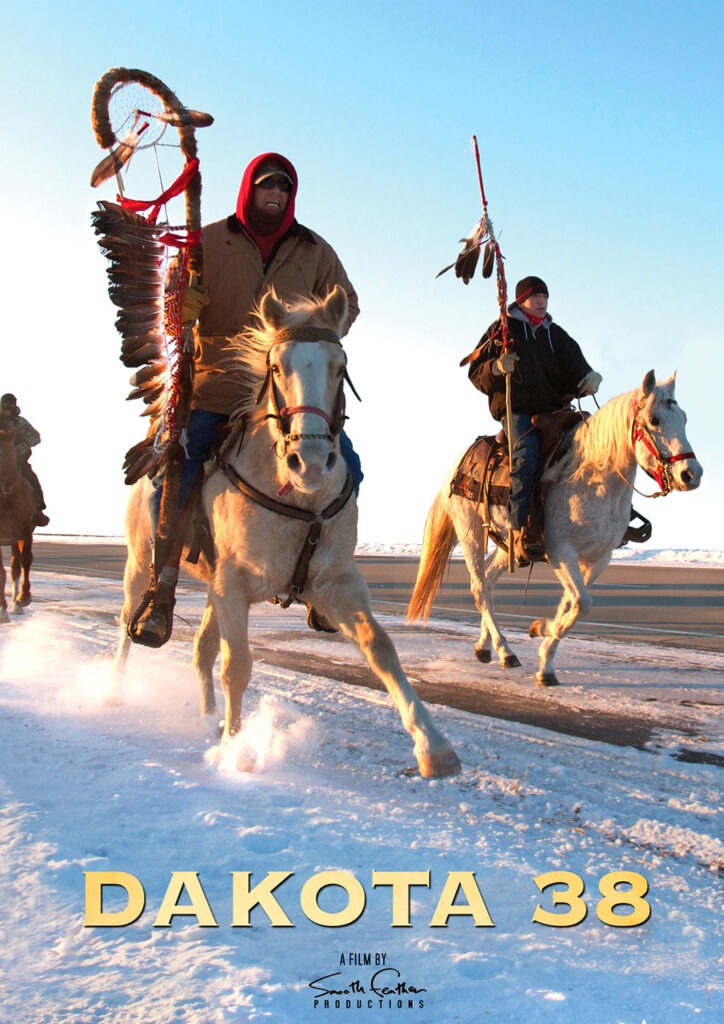
Watch Dakota 38 Documentary, Remember Those Lost 150 Years Ago
Watch Dakota 38 Documentary, Remember Those Lost 150 Years Ago
ICTMN Staff 12/22/12 | indiancountrytodaymedianetwork.com

As the Dakota 38 riders make their way to Mankato, Minnesota to honor and remember the 38 men who lost their lives on December 26, 1862 in the largest mass execution ever seen in the United States, you may be wondering how you can honor them from wherever you are. By learning and reconciling. Watching the documentary film Dakota 38 by Smooth Feather productions is one way to do that. The film follows the riders on their 330-mile journey from Lower Brule, South Dakota to Mankato where the riders will arrive on December 26, 2012. “These riders they come from all over, Canada, Montana, Iowa, South Dakota, North Dakota, Minnesota—There’s even a guy here from Austria—it’s from all over the world these riders come,” says Peter Lengkeek in the video. “And that’s the point, that’s what we’re trying to do here is we’re trying to reconcile, unite, make peace with everyone because that’s what it means to be Dakota. To be Dakota means to walk in peace and harmony with every living thing.
That is our way.” Lengkeek’s great-great grandfather, Walks With Owl Tail was one of the 38 who was executed in Mankato after the U.S.-Dakota War of 1862, the order was signed by President Abraham Lincoln. The ride was started after Jim Miller had a vision of the 38 Dakota men being hanged in 2005. Miller, a recovered alcoholic and Vietnam veteran dismissed the vision at first. “When you have dreams, you know when they come from the Creator. As any recovered alcoholic, I made believe that I didn’t get it. I tried to put it out of my mind, yet it’s one of those dreams that bothers you night and day,” Miller says in the film. “We can’t blame the wasi’chus anymore. We’re doing it to ourselves. We’re selling drugs. We’re killing our own people. That’s what this ride is about, is healing.”
He hadn’t even heard about the hanging at Mankato before this dream, but once he put his mind to starting the ride Miller, who is a direct descendant of Little Horse, one of the 38, was joined by other Dakota descendants. Miller has seen his share of rough times, but is more than willing now to be there for anyone who wants to share their burden with him. In the film, he encourages anyone who needs to talk to come and speak with him about anything. The film is, at times, difficult to watch. Footage of riders is interspersed with interviews and haunting historic images of the hanging and information about the removal of the Dakota people from Minnesota. But it’s also moving, informative and shows the helping spirit of those along the way. “I watched only half because my tears kept me from seeing. This is one of the most important films ever made,” film viewer Thomas Hodges says on the Smoother Feather website.
“It should be required viewing for every American citizen from middle school through old age. These brave, courageous people and those who helped them on their journey and those who made this film are the most honorable human beings I have witnessed in a long time. Words cannot possibly express my gratitude and humility, so accept my deepest bows for this inspiration.” The film makes it clear that the journey isn’t only about remembering those 38 Dakota men; it’s also about healing, reconciliation and getting back to traditional ways. Mikey Peters, Medicine Bottle’s great-great grandson, tells the importance of the horse. How the animal represents the directions used in ceremonies. The two front legs represent the west and the north, the two back legs represent the east and the south, the head and ears point up toward Wakatahe and the tail points down, toward Mother Earth.
“When you put those six directions together it creates a sacred center to bring Wowakan—it’s a sacredness that you can only have with these six directions. And you can pray while you’re on your horse.” Peters says in the film. “Some people can remember things that ancestors went through. It’s the horse leading the way because of its healing power.” The making of the film wasn’t without racial tension, some of the film crew wasn’t Native, but in the end the result was a story of hope. “This documentary is about both of our cultures,” Silas Hagerty, the film’s non-Native director told The Cannon Falls Beacon. “On the outside you could say it’s about Native Americans, but it’s really about the connection of both our cultures and how we all need to work through this tragic past.” Smooth Feather Productions is not charging for the film. It’s available for free on YouTube and DVDs can be ordered on their website at SmoothFeather.org. Watch it here:





Responses